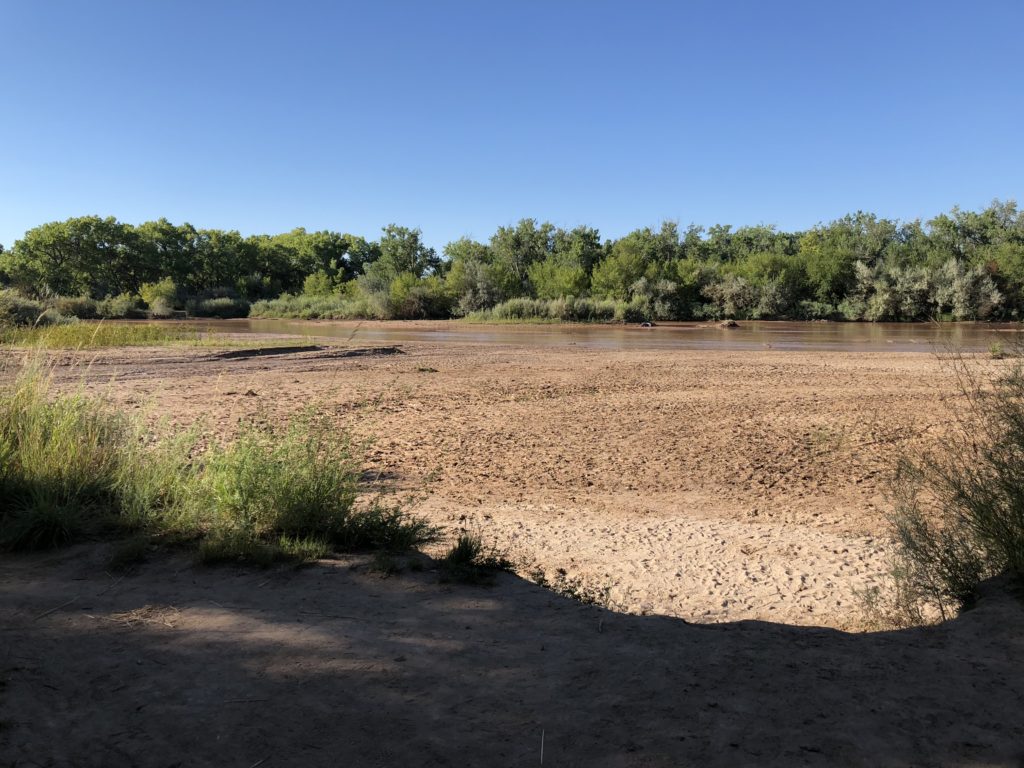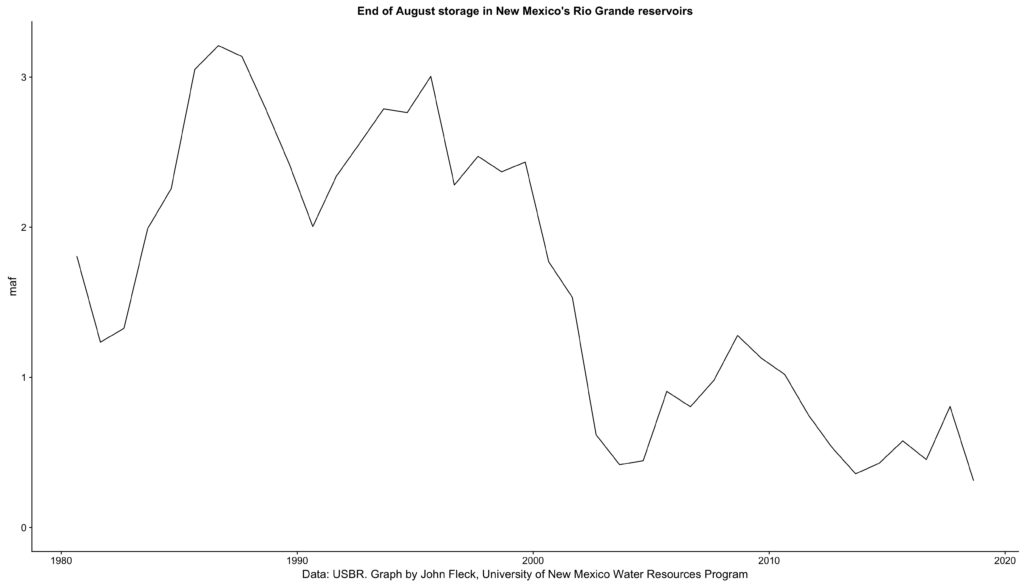tl;dr
Total reservoir storage on the Rio Grande in New Mexico at the end of August was the lowest it’s been since at least 1980.
longer (with graphs!)
In our University of New Mexico Water Resources Program class, we’ve been discussing the state of the Rio Grande in real time. This feels like a remarkable moment, for teaching.
The water managers down on New Mexico’s Lower Rio Grande have made the conscious decision to essentially drain Elephant Butte Reservoir – the primary source of surface water supplies for farmers in the Hatch and Mesilla valleys. Elephant Butte, a 2 million acre foot reservoir, ended August with just 85,000 acre feet of water, something like 4 percent of capacity. That’s the lowest it’s been at this point in the year since 1972.
Simultaneously, we’ve made a similar decision upstream – draining Abiquiu, El Vado, and Heron reservoirs on the Rio Chama in order to continue deliveries to farmers in this part of the state, with some water devoted to instream flows for the endangered Rio Grande silvery minnow.
We essentially manage the two parts of the system separately, but I was wondering what it would look like if we looked at them together:
The US Bureau of Reclamation datasets available on a Sunday afternoon lack the necessary detail prior to 1980 for some of the reservoirs, so that’s as far back as the graph goes.
We’re draining these things and hoping for a wet winter.



John
I have somewhere all of the pre-1980 data. We used it in Jicarilla v.l City of Albuquerque in 1979.
More water is lost to evaporation from
reservoirs in New Mexico than is put to beneficial use.
Not sure whether Van Clothier statement is correct, but it probably makes sense to drain reservoirs to a minimum rather than overdraw from aquifers, as evaporation is very significant and will be increasing with hotter summers due to global warming. It would be interesting to have data on monthly groundwater withdrawal from urban areas, and to see cities start to move toward subsidizing rainwater harvesting and increasing reclamation of wastewater rather than overdraw from aquifers, which risks draconian measures be taken.
Van – I’m curious about your source.
The most recent New Mexico Office of State Engineer “Water Use By Categories” report puts reservoir evaporation at 262,000 acre feet per year, as compared to 3 million acre feet per year for agriculture, and 317,000 acre feet per year for municipal use.
Mild comment on the graph: would be nice to see a maximum possible storage line, as well as lines at the half-maf measures as well as at 5-year increments. Kinda hard to see what falls where or make comparisons in this (which is still pretty cool).
Bill, you’re talking about this case? Whatever resulted beyond what’s here?
https://law.justia.com/cases/federal/appellate-courts/F2/657/1126/395425/
JF concludes “We essentially manage the two parts of the system separately, but I was wondering what it would look like if we looked at them together” which I surmise is something Texas is hoping for as an outcome to the Texas V New Mexico case. Unknown impacts to Middle Rio Grande stakeholders. https://www.nmag.gov/uploads/files/RGCL/55%20Amicus%20-%20Albuquerque%20BernCo%20WUA.pdf
What about all fish, aquatic life, wildlife that depend on these water sources?
Is it time to buyout farmers? Not sure they would accept it. I know is blasphemous to say such a thing and will probably fire some people up but really does agriculture belong in the desert? The river has dried up. The morphology of the Rio Grande has been altered due to sediment storage from a braided sand bed system to a single thread meandering river that no longer supports the wildlife native to the river. Restoration efforts that cut down vegetation on mid-channel bars to encourage the braiding last one growing season. A lot of money is spent trying to mechanically do what nature did with floods. We have tried to control nature and now we are at the limits.
The large dams do not allow the river to function the way it was intended. Is it time to get over the sunk cost of all these dams and remove them?
Pingback: The draining of New Mexico's reservoirs continues - jfleck at inkstain
John, Thanks for your continued interest in the water issues on the Rio Grande. I have heard that a National Academy of Science study might be coming on this topic and they may want to talk to you when they get started. I’ve been working on the fisheries at Elephant Butte and it is a real challenge to make a difference with the dramatic draw downs but we have had some success. Thanks again. Earl Conway, Conservation Director for New Mexico BASS Nation